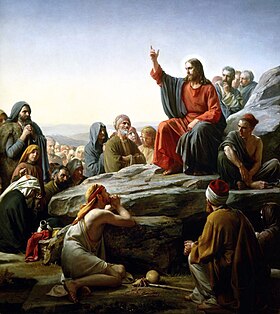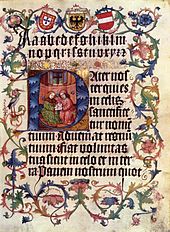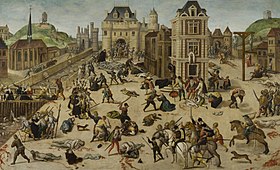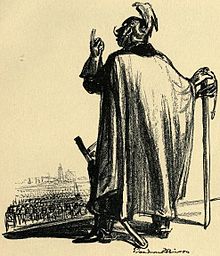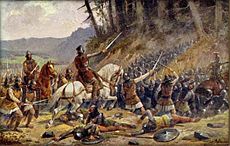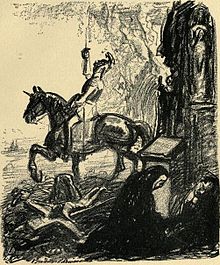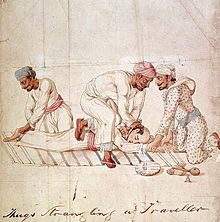Religious violence covers phenomena in which religion is either the subject or the object of violent behavior. All the religions of the world contain narratives, symbols, and metaphors of violence and war. Religious violence is violence
that is motivated by, or in reaction to, religious precepts, texts, or
the doctrines of a target or an attacker. It includes violence against
religious institutions, people, objects, or events. Religious violence
does not exclusively include acts which are committed by religious
groups, instead, it includes acts which are committed against religious
groups.
"Violence" is a very broad concept which is difficult to define because it is used against both human and non-human objects.
Furthermore, the term can denote a wide variety of experiences such as
blood shedding, physical harm, forcing against personal freedom,
passionate conduct or language, or emotions such as fury and passion.
"Religion" is a complex and problematic modern western concept. Though there is no scholarly consensus over what a religion is,
today, religion is generally considered an abstraction which entails
beliefs, doctrines, and sacred places. The link between religious belief
and behavior is problematic. Decades of anthropological, sociological,
and psychological research have all proven the falsehood of the
assumption that behaviors directly follow from religious beliefs and
values because people's religious ideas are fragmented, loosely
connected, and context-dependent just like all other domains of culture
and life.
In general, religions, ethical systems, and societies rarely promote
violence as an end in itself since violence is universally undesirable.
At the same time, there is a universal tension between the general
desire to avoid violence and the acceptance of justifiable uses of
violence to prevent a "greater evil" that permeates all cultures.
Religious violence, like all forms of violence, is a cultural process which is context-dependent and very complex.
Oversimplifications of "religion" and "violence" often lead to
misguided understandings of causes for why some people commit acts of
violence and why most people never commit such acts in the first place. Violence is perpetrated for a wide variety of ideological
reasons and religion is generally only one of many contributing social
and political factors that can lead to unrest. Studies of supposed cases
of religious violence often conclude that violence is strongly driven
by ethnic animosities rather than by religious worldviews.
Due to the complex nature of religion and violence and the complex
relationship which exists between them, it is normally unclear if
religion is a significant cause of violence.
History of the concept of religion
Religion is a modern Western concept.
The compartmentalized concept of religion, where religious things were
separated from worldly things, was not used before the 1500s. Furthermore, parallel concepts are not found in many cultures and there is no equivalent term for "religion" in many languages. Scholars have found it difficult to develop a consistent definition, with some giving up on the possibility of a definition and others rejecting the term entirely. Others argue that regardless of its definition, it is not appropriate to apply it to non-Western cultures.
The modern concept of "religion" as an abstraction which entails
distinct sets of beliefs or doctrines is a recent invention in the
English language since such usage began with texts from the 17th century
due to the splitting of Christendom during the Protestant Reformation and more prevalent colonization or globalization in the age of exploration which involved contact with numerous foreign and indigenous cultures with non-European languages.
Ancient sacred texts like the Bible and the Quran
did not have a concept of religion in their original languages and
neither did their authors or the cultures to which they belonged. It was in the 19th century that the terms "Buddhism", "Hinduism", "Taoism", and "Confucianism" first emerged.
There is no precise equivalent of "religion" in Hebrew, and Judaism does not draw clear distinctions between religious, national, racial, or ethnic identities.
Definition of violence
Violence
is difficult to define because the term is a complicated concept which
broadly carries descriptive and evaluative components which range from
harming non-human objects to human self-harm.
Ralph Tanner cites the definition of violence in the Oxford English
Dictionary as "far beyond (the infliction of) pain and the shedding of
blood." He argues that, although violence clearly encompasses injury to
persons or property, it also includes "the forcible interference in
personal freedom, violent or passionate conduct or language (and)
finally passion or fury."
Similarly, Abhijit Nayak writes:
The word "violence" can be defined to extend far beyond pain and
shedding blood. It carries the meaning of physical force, violent
language, fury, and, more importantly, forcible interference.
Terence Fretheim writes:
For many people, ... only physical violence truly qualifies as
violence. But, certainly, violence is more than killing people, unless
one includes all those words and actions that kill people slowly. The
effect of limitation to a “killing fields” perspective is the widespread
neglect of many other forms of violence. We must insist that violence
also refers to that which is psychologically destructive, that which
demeans, damages, or depersonalizes others. In view of these
considerations, violence may be defined as follows: any action, verbal
or nonverbal, oral or written, physical or psychical, active or passive,
public or private, individual or institutional/societal, human or
divine, in whatever degree of intensity, that abuses, violates, injures,
or kills. Some of the most pervasive and most dangerous forms of
violence are those that are often hidden from view (against women and
children, especially); just beneath the surface in many of our homes,
churches, and communities is abuse enough to freeze the
blood. Moreover, many forms of systemic violence often slip past our
attention because they are so much a part of the infrastructure of life
(e.g., racism, sexism, ageism).
Relationship between religion and violence
According
to Steve Clarke, "currently available evidence does not allow us to
determine whether religion is, or is not, a significant cause of
violence." He lists multiple problems that make it impossible to
establish a causal relationship such as difficulties in distinguishing
motive/pretext and inability to verify if they would necessarily lead to
any violent action, the lack of consensus of definitions of both
violence and religion among scholars, and the inability to see if the
presence of religion actually adds or subtracts from general levels of
violence since no society without religion has ever existed to compare
with.
Charles Selengut characterizes the phrase "religion and violence"
as "jarring", asserting that "religion is thought to be opposed to
violence and a force for peace and reconciliation." He acknowledges,
however, that "the history and scriptures of the world's religions tell
stories of violence and war even as they speak of peace and love."
According to Matthew Rowley, three hundred contributing causes of
religious violence have been discussed by some scholars, however, he
states that "violence in the name of God is a complex phenomenon and
oversimplification further jeopardizes peace because it obscures many of
the causal factors."
In another piece, Matthew Rowley lists 15 ways to address the
complexity of violence, both secular and religious, and he also states
that secular narratives of religious violence tend to be erroneous or
exaggerated due to their over simplification of religious people, their
oversimplification of religious people's beliefs, their thinking which
is based on false dichotomies, and their ignorance of complex secular
causes of supposed "religious violence". He also states that when one is
discussing religious violence, he or she should also note that the
overwhelming majority of religious people do not get inspired to engage
in violence.
Similarly, Ralph Tanner describes the combination of religion and
violence as "uncomfortable", asserting that religious thinkers
generally avoid the conjunction of the two and argue that religious
violence is "only valid in certain circumstances which are invariably
one-sided".
Michael Jerryson argues that scholarship on religion and violence
sometimes overlooks non-Abrahamic religions. This tendency leads to
considerable problems, one of which is the support of faulty
associations. For example, he finds a persistent global pattern of
alignment in which religions such as Islam are viewed as causes of
violence and religions such as Buddhism are viewed as causes of peace.
In many instances of political violence, religion tends to play a central role. This is especially true of terrorism,
in which acts of violence are committed against unarmed noncombatants
in order to inspire fear and achieve political goals. Terrorism expert Martha Crenshaw
suggests that religion is just a mask which is used by political
movements which seek to draw attention to their causes and gain support.
Crenshaw outlines two approaches when she observes religious violence
in order to view its underlying mechanisms.
One approach, called the instrumental approach, sees religious violence
as acting as a rational calculation to achieve some political end.
Increasing the costs of performing such violence will help curb it.
Crenshaw's alternate approach sees religious violence stemming from the
organizational structure of religious communities, with the heads of
these communities acting as political figureheads. Crenshaw suggests
that threatening the internal stability of these organizations (perhaps
by offering them a nonviolent alternative) will dissuade religious
organizations from performing political violence. A third approach sees
religious violence as the result of community dynamics rather than a
religious duty. Systems of meanings
which are developed within these communities allow religious
interpretations to justify violence, so acts like terrorism occur
because people are part of communities of violence.
In this way, religious violence and terrorism are performances which
are designed to inspire an emotional reaction from both those in the
community and those outside of it.
Hector Avalos
argues that religions cause violence over four scarce resources: access
to divine will, knowledge, primarily through scripture; sacred space;
group privileging; and salvation. Not all religions have or use these
four resources. He believes that religious violence is particularly
untenable because these resources are never verifiable and, unlike
claims to scarce resources such as water or land, it cannot be
adjudicated objectively.
Regina Schwartz
argues that all monotheistic religions are inherently violent because
of an exclusivism that inevitably fosters violence against those that
are considered outsiders.
Lawrence Wechsler asserts that Schwartz isn't just arguing that
Abrahamic religions have a violent legacy, she is arguing that their
legacy is genocidal in nature.
Challenges to the view that religions are violent
Behavioral studies
Decades
of research which was conducted by social scientists have established
that "religious congruence" (the assumption that religious beliefs and
values are tightly integrated in an individual's mind or that religious
practices and behaviors follow directly from religious beliefs or that
religious beliefs are chronologically linear and stable across different
contexts) is actually rare. People's religious ideas are fragmented,
loosely connected, and context-dependent, as in all other domains of
culture and in life. The beliefs, affiliations, and behaviors of any
individual are complex activities that have many sources including
culture.
Myth of religious violence
Others
such as William Cavanaugh have argued that it is unreasonable to
attempt to differentiate "religious violence" from "secular violence" by
classifying them as separate categories of violence. Cavanaugh asserts
that "the idea that religion has a tendency to promote violence is part
of the conventional wisdom of Western societies and it underlies many of
our institutions and policies, from limits on the public role of
churches to efforts to promote liberal democracy in the Middle East."
Cavanaugh challenges this conventional wisdom, arguing that there is a
"myth of religious violence", basing his argument on the assertion that
"attempts to separate religious and secular violence are incoherent".
Cavanaugh asserts:
- Religion is not a universal and transhistorical phenomenon. What
counts as "religious" or "secular" in any context is a function of
configurations of power both in the West and lands colonized by the
West. The distinctions of "Religious/Secular" and "Religious/Political"
are modern Western inventions.
- The invention of the concept of "religious violence" helps the West
reinforce superiority of Western social orders to "nonsecular" social
orders, namely Muslims at the time of publication.
- The concept of "religious violence" can be and is used to legitimate violence against non-Western "Others".
- Peace depends on a balanced view of violence and recognition that
so-called secular ideologies and institutions can be just as prone to
absolutism, divisiveness, and irrationality.
Jeffrey Russell argues that numerous cases of supposed acts of religious violence such as the Thirty Years War, the French Wars of Religion, the Protestant-Catholic conflict in Ireland, the Sri Lankan Civil War, and the Rwandan Civil War were all primarily motivated by social, political, and economic issues rather than religion.
John Morreall and Tamara Sonn have argued that all cases of
violence and war include social, political, and economic dimensions.
Since there is no consensus on definitions of "religion" among scholars
and since there is no way to isolate "religion" from the rest of the
more likely motivational dimensions, it is incorrect to label any
violent event as "religious". They state that since dozens of examples exist from the European wars of religion
that show that people from the same religions fought each other and
that people from different religions became allies during these
conflicts, the motivations for these conflicts were not about religion.
Jeffrey Burton Russell has argued that the fact that these wars of
religion ended after rulers agreed to practice their religions in their
own territories, means that the conflicts were more related to political
control than about people's religious views.
According to Karen Armstrong, so-called religious conflicts such as the Crusades, the Spanish Inquisition,
and the European wars of religion, were all deeply political conflicts
at their cores, rather than religious ones. Especially since people from
different faiths constantly became allies and fought against each other
in no consistent fashion. She states that the Western concept of the
separation of church and state, which was first advocated by the
Reformer Martin Luther,
laid a foundation for viewing religion and society as being divided
when in reality, religion and society were intermixed to the point that
no one made such a distinction nor was there a defining cut between such
experiences in the past. During the Enlightenment,
religion began to be seen as an individualistic and private thing
despite the fact that modern secular ideals like the equality of all
human beings, intellectual and political liberty were things that were
historically promoted in a religious idiom in the past.
Anthropologist Jack David Eller asserts that religion is not
inherently violent, arguing "religion and violence are clearly
compatible, but they are not identical." He asserts that "violence is
neither essential to nor exclusive to religion" and that " virtually
every form of religious violence has its nonreligious corollary."
Moreover, he argues that religion "may be more a marker of the
[conflicting] groups than an actual point of contention between them".
John Teehan takes a position that integrates the two opposing sides of
this debate. He describes the traditional response in defense of
religion as "draw(ing) a distinction between the religion and what is
done in the name of that religion or its faithful." Teehan argues, "this
approach to religious violence may be understandable but it is
ultimately untenable and prevents us from gaining any useful insight
into either religion or religious violence." He takes the position that
"violence done in the name of religion is not a perversion of religious
belief... but flows naturally from the moral logic inherent in many
religious systems, particularly monotheistic religions...." However,
Teehan acknowledges that "religions are also powerful sources of
morality." He asserts, "religious morality and religious violence both
spring from the same source, and this is the evolutionary psychology
underlying religious ethics."
Historians such as Jonathan Kirsch
have made links between the European inquisitions, for example, and
Stalin's persecutions in the Soviet Union, Nazi Germany, McCarthy
blacklists, and other secular events as being the same type of
phenomenon as the inquisitions.
Others, such as Robert Pape,
a political scientist who specializes in suicide terrorism, have made a
case for secular motivations and reasons as being foundations of most
suicide attacks that are oftentimes labeled as "religious".
Pape compiled the first complete database of every documented suicide
bombing during 1980–2003. He argues that the news reports about suicide attacks are profoundly misleading — "There is little connection between suicide terrorism and Islamic fundamentalism,
or any one of the world's religions". After studying 315 suicide
attacks carried out over the last two decades, he concludes that suicide
bombers' actions stem fundamentally from political conflict, not
religion.
Secularism as a response
Byron
Bland asserts that one of the most prominent reasons for the "rise of
the secular in Western thought" was the reaction against the religious
violence of the 16th and 17th centuries. He asserts that "(t)he secular
was a way of living with the religious differences that had produced so
much horror. Under secularity, political entities have a warrant to make
decisions independent from the need to enforce particular versions of
religious orthodoxy. Indeed, they may run counter to certain strongly
held beliefs if made in the interest of common welfare. Thus, one of the
important goals of the secular is to limit violence." William T. Cavanaugh
writes that what he calls "the myth of religious violence" as a reason
for the rise of secular states may be traced to earlier philosophers,
such as Spinoza, Hobbes, Locke, Rousseau, and Voltaire. Cavanaugh delivers a detailed critique of this idea in his 2009 book The Myth of Religious Violence: Secular Ideology and the Roots of Modern Conflict.
Secular violence
Janet Jakobsen states that "just as religion and secularism are
relationally defined terms - terms that depend on each other - so also
the legitimization of violence through either religious or secular
discourse is also relational."
She states that the idea that "religion kills" is used to legitimate
secular violence, and that, similarly, the idea that "secularism kills"
is used to legitimate religious violence.
According to John Carlson, critics who are skeptical of "religious
violence" contend that excessive attention is often paid to acts of
religious violence compared to acts of secular violence, and that this
leads to a false essentializing of both religion as being prone to
violence and the secular as being prone to peace.
According to Janet Jakobsen, secularism and modern secular states are
much more violent than religion, and modern secular states in particular
are usually the source of most of the world's violence.
Carlson states that by focusing on the destructive capacity of
government, Jakobsen "essentializes another category - the secular state
- even as she criticizes secular governments that essentialize
religion's violent propensities". Tanner states that secular regimes and leaders have used violence to promote their own agendas.
Violence committed by secular governments and people, including the
anti-religious, have been documented including violence or persecutions
focused on religious believers and those who believe in the
supernatural. In the 20th century, estimates state that over 25 million Christians died from secular antireligious violence worldwide.
Religions have been persecuted more in the past 100 years than at any other time in history.
According to Geoffrey Blainey, atrocities have occurred under all
ideologies, including in nations which were strongly secular such as the
Soviet Union, China, and Cambodia. Talal Asad, an anthropologist, states that equating institutional religion
with violence and fanaticism is incorrect and that devastating
cruelties and atrocities done by non-religious institutions in the 20th
century should not be overlooked. He also states that nationalism has
been argued as being a secularized religion.
Abrahamic religions
Hector Avalos
argues that, because religions claim to have divine favor for
themselves, both over and against other groups, this sense of
self-righteousness leads to violence because conflicting claims of
superiority, based on unverifiable appeals to God, cannot be objectively
adjudicated.
Similarly, Eric Hickey writes, "the history of religious violence
in the West is as long as the historical record of its three major
religions, Judaism, Christianity, and Islam,
with their mutual antagonisms and their struggles to adapt and survive
despite the secular forces that threaten their continued existence."
Regina Schwartz argues that all monotheistic religions, including Christianity,
are inherently violent because of their exclusivism which inevitably
fosters violence against those who are considered outsiders. Lawrence Wechsler asserts that Schwartz isn't just arguing that Abrahamic religions have a violent legacy, instead, she is arguing that their legacy is actually genocidal in nature.
Christianity
Before the 11th century, Christians had not developed the doctrine of "Holy war", the belief that fighting itself might be considered a penitential and spiritually meritorious act. Throughout the Middle Ages, force could not be used to propagate religion. For the first three centuries of Christianity, the Church taught the pacifism of Jesus and notable church fathers such as Justin Martyr, Tertullian, Origen, and Cyprian of Carthage even went as far as arguing against joining the military or using any form of violence against aggressors. In the 4th century, St. Augustine
developed a "Just War" concept, whereby limited uses of war would be
considered acceptable in order to preserve the peace and retain
orthodoxy if it was waged: for defensive purposes, ordered by an
authority, had honorable intentions, and produced minimal harm. However,
the criteria he used was already developed by Roman thinkers in the
past and "Augustine's perspective was not based on the New Testament." St. Augustine's "Just War" concept was widely accepted, however, warfare was not regarded as virtuous in any way.
Expression of concern for the salvation of those who killed enemies in
battle, regardless of the cause for which they fought, was common. In the medieval period which began after the fall of Rome,
there were increases in the level of violence due to political
instability. By the 11th century, the Church condemned this violence and
warring by introducing: the "Peace of God" which prohibited attacks on
clergy, pilgrims, townspeople, peasants and property; the "Truce of God"
which banned warfare on Sundays, Fridays, Lent, and Easter;
and it imposed heavy penances on soldiers for killing and injuring
others because it believed that the shedding of other people's blood was
the same as shedding the blood of Christ.
During the 9th and 10th centuries, multiple invasions occurred in
some regions in Europe and these invasions lead them to form their own
armies in order to defend themselves and by the 11th century, this
slowly lead to the emergence of the Crusades, the concept of "holy war",
and terminology such as "enemies of God".
By the time of the Crusades, "Despite all the violence during this
period, the majority of Christians were not active participants but were
more often its victims" and groups which used nonviolent means to
peacefully dialogue with Muslims were established, like the Franciscans.
Today, the relationship between Christianity and violence
is the subject of controversy because one view advocates the belief
that Christianity advocates peace, love and compassion despite the fact
that in certain instances, its adherents have also resorted to violence.
Peace, compassion and forgiveness of wrongs done by others are key
elements of Christian teaching. However, Christians have struggled since
the days of the Church fathers with the question of when the use of force is justified (e.g. the Just war theory of Saint Augustine). Such debates have led to concepts such as just war theory. Throughout history, certain teachings from the Old Testament, the New Testament and Christian theology have been used to justify the use of force against heretics, sinners and external enemies. Heitman and Hagan identify the Inquisitions, Crusades, wars of religion, and antisemitism as being "among the most notorious examples of Christian violence". To this list, Mennonite theologian J. Denny Weaver adds "warrior popes, support of capital punishment, corporal punishment under the guise of 'spare the rod spoil the child,' justifications of slavery, world-wide colonialism under the guise of converting people to Christianity, the systemic violence against women who are subjected to the rule of men."
Weaver employs a broader definition of violence that extends the
meaning of the word to cover "harm or damage", not just physical
violence per se. Thus, under his definition, Christian violence includes
"forms of systemic violence such as poverty, racism, and sexism".
Christian theologians point to a strong doctrinal and historical imperative against violence that exists within Christianity, particularly Jesus' Sermon on the Mount,
which taught nonviolence and "love of enemies". For example, Weaver
asserts that Jesus' pacifism was "preserved in the justifiable war
doctrine which declares that all war is sin even when it is occasionally
declared to be a necessary evil, and in the prohibition of fighting by
monastics and clergy as well as in a persistent tradition of Christian pacifism".
Between 1420 and 1431 the
Hussite heretics fended off 5 anti-Hussite
Crusades ordered by the Pope.
Many authors highlight the ironical contradiction between
Christianity's claims to be centered on "love and peace" while, at the
same time, harboring a "violent side". For example, Mark Juergensmeyer
argues: "that despite its central tenets of love and peace,
Christianity—like most traditions—has always had a violent side. The
bloody history of the tradition has provided images as disturbing as
those provided by Islam,
and violent conflict is vividly portrayed in the Bible. This history
and these biblical images have provided the raw material for
theologically justifying the violence of contemporary Christian groups.
For example, attacks on abortion clinics
have been viewed not only as assaults on a practice that Christians
regard as immoral, but also as skirmishes in a grand confrontation
between forces of evil and good that has social and political
implications.", sometimes referred to as spiritual warfare. The statement attributed to Jesus "I come not to bring peace, but to bring a sword" has been interpreted by some as a call to arms to Christians.
Maurice Bloch
also argues that the Christian faith fosters violence because the
Christian faith is a religion, and religions are violent by their very
nature; moreover, he argues that religion and politics are two sides of
the same coin—power.
Others have argued that religion and the exercise of force are deeply
intertwined, but they have also stated that religion may pacify, as well
as channel and heighten violent impulses
In response to the view that Christianity and violence are
intertwined, Miroslav Volf and J. Denny Weaver reject charges that
Christianity is a violent religion, arguing that certain aspects of
Christianity might be misused to support violence but that a genuine
interpretation of its core elements would not sanction human violence
but would instead resist it. Among the examples that are commonly used
to argue that Christianity is a violent religion, J. Denny Weaver lists
"(the) Crusades,
the multiple blessings of wars, warrior popes, support of capital
punishment, corporal punishment under the guise of 'spare the rod and
spoil the child,' justifications of slavery, world-wide colonialism in
the name of converting people to Christianity, the systemic violence
against women who are subjected to the rule of men." Weaver
characterizes the counter-argument as focusing on "Jesus, the beginning
point of Christian faith,... whose Sermon on the Mount taught
nonviolence and love of enemies,; who nonviolently faced his death at
the hands of his accusers; whose nonviolent teaching inspired the first
centuries of pacifist Christian history and was subsequently preserved
in the justifiable war doctrine
that declares that all war is sin even when it is occasionally declared
to be a necessary evil, and in the prohibition of fighting by monastics
and clergy as well as in a persistent tradition of Christian pacifism."
Miroslav Volf
acknowledges the fact that "many contemporaries see religion as a
pernicious social ill that needs aggressive treatment rather than
medicine from which a cure is expected." However, Volf contests the
claim that "(the) Christian faith, as one of the major world religions,
predominantly fosters violence." Instead of this negative assessment,
Volf argues that Christianity "should be seen as a contributor to more
peaceful social environments."
Volf examines the question of whether or not Christianity fosters
violence, and he has identified four main arguments which claim that it
does: that religion by its nature is violent, which occurs when people
try to act as "soldiers of God"; that monotheism entails violence,
because a claim of universal truth divides people into "us versus them";
that creation, as in the Book of Genesis, is an act of violence; and the argument that the intervention of a "new creation", as in the Second Coming, generates violence.
Writing about the latter, Volf says: "Beginning at least with
Constantine's conversion, the followers of the Crucified have
perpetrated gruesome acts of violence under the sign of the cross. Over
the centuries, the seasons of Lent and Holy Week were, for the Jews, times of fear and trepidation; Christians have perpetrated some of the worst pogroms as they remembered the crucifixion of Christ, for which they blamed the Jews. Muslims also associate the cross with violence; crusaders' rampages were undertaken under the sign of the cross."
In each case, Volf concluded that the Christian faith was misused in
order to justify violence. Volf argues that "thin" readings of
Christianity might be used mischievously to support the use of violence.
He counters, however, by asserting that "thick" readings of
Christianity's core elements will not sanction human violence, instead,
they will resist it.
Volf asserts that Christian churches suffer from a "confusion of
loyalties". He asserts that "rather than the character of the Christian
faith itself, a better explanation as to why Christian churches are
either impotent in the face of violent conflicts or are active
participants in them is derived from the proclivities of its adherents
which are at odds with the character of the Christian faith." Volf
observes that "(although) they are explicitly giving ultimate allegiance
to the Gospel of Jesus Christ, many Christians in fact seem to have an
overriding commitment to their respective cultures and ethnic groups."
The Church of Jesus Christ of Latter-day Saints
The Church of Jesus Christ of Latter-day Saints has an early history of violence. It was motivated by Anti-Mormonism and began with the religious persecution of the Church
by well respected citizens, law enforcement, and government officials.
Ultimately, this persecution lead to several historically well-known
acts of violence. These ranged from attacks on early members, such as
the Haun's Mill massacre following the Mormon Extermination Order to one of the most controversial and well-known cases of retaliation violence, the Mountain Meadows massacre.
This was the result of an unprovoked response to religious persecution
whereby an innocent party which was traveling through Church occupied
territory was attacked on 11 September 1857.
Islam
Islam has been associated with violence in a variety of contexts, especially in the context of Jihad. In Arabic, the word jihād
translates into English as "struggle". Jihad appears in the Qur'an and
frequently in the idiomatic expression "striving in the way of Allah (al-jihad fi sabil Allah)".
The context of the word can be seen in its usage in Arabic translations
of the New Testament such as in 2 Timothy 4:7 where St. Paul expresses
keeping the faith after many struggles. A person engaged in jihad is called a mujahid; the plural is mujahideen. Jihad is an important religious duty for Muslims. A minority among the Sunni scholars sometimes refer to this duty as the sixth pillar of Islam, though it occupies no such official status. In Twelver Shi'a Islam, however, Jihad is one of the ten Practices of the Religion.
For some the Quran seem to endorse unequivocally to violence. On the other hand, some scholars argue that such verses of the Quran are interpreted out of context.
According to a study from Gallup, most Muslims understand the
word "Jihad" to mean individual struggle, not something violent or
militaristic.
Muslims use the word in a religious context to refer to three types of
struggles: an internal struggle to maintain faith, the struggle to
improve the Muslim society, or the struggle in a holy war. The prominent British orientalist Bernard Lewis argues that in the Qur'an and the hadith jihad implies warfare in the large majority of cases. In a commentary of the hadith Sahih Muslim, entitled al-Minhaj, the medieval Islamic scholar Yahya ibn Sharaf al-Nawawi stated that "one of the collective duties of the community as a whole (fard kifaya)
is to lodge a valid protest, to solve problems of religion, to have
knowledge of Divine Law, to command what is right and forbid wrong
conduct".
Islam has a history of nonviolence and negotiation when dealing with
conflicts. For instance, early Muslims experienced 83 conflicts with
non-Muslims and only 4 of these ended up in armed conflict.
Terrorism and Islam
In western societies the term jihad is often translated as "holy war". Scholars of Islamic studies often stress the fact that these two terms are not synonymous. Muslim authors, in particular, tend to reject such an approach, stressing the non-militant connotations of the word.
Islamic terrorism refers to terrorism that is engaged in by Muslim groups or individuals who are motivated by either politics, religion or both. Terrorist acts have included airline hijacking, kidnapping, assassination, suicide bombing, and mass murder.
The tension reached a climax on 11 September 2001 when Islamic terrorists flew hijacked commercial airplanes into the World Trade Center in New York City and the Pentagon in Washington, D.C. The "War on Terror" has triggered anti-Muslim sentiments within most western countries and throughout the rest of the world. Al-Qaeda is one of the most well-known Islamic extremist groups, created by Osama bin Mohammed bin Awad bin Laden. Al-Qaeda's goal is to spread the "purest" form of Islam and Islamic law.
Based on his interpretation of the Quran, bin Laden needed to do "good"
by inflicting terror upon millions of people. Following the terrorist
attacks on 11 September, bin Laden praised the suicide bombers in his statement: "the great action you did which was first and foremost by the grace of Allah.
This is the guidance of Allah and the blessed fruit of jihad." In
contrast, echoing the overwhelming majority of people who interpreted
these events, President Bush
said on 11 September, "Freedom itself was attacked this morning by a
faceless coward. ... And freedom will be defended. Make no mistake, the
United States will hunt down and punish those responsible for these
cowardly acts."
Controversies surrounding the subject include disagreements over
whether terrorist acts are self-defense or aggression, national
self-determination or Islamic supremacy; whether Islam can ever condone
the targeting of non-combatants; whether some attacks described as
Islamic terrorism are merely terrorist acts committed by Muslims or
terrorist acts motivated by nationalism; whether Wahhabism
are at the root of Islamic terrorism, or simply one cause of it; how
much support for Islamic terrorism exists in the Muslim world and whether support of terrorism is only a temporary phenomenon, a "bubble", now fading away.
Judaism
As the religion of the Jews, who are also known as Israelites, Judaism is based on the Torah and the Tanakh, which is also referred to as the Hebrew Bible, and it guides its adherents on how to live, die, and fight via the 613 commandments which are referred to as the 613 Mitzvahs, the most famous of which are the Ten Commandments, one of which is the commandment You shall not murder.
The Torah also lists instances and circumstances which require
its adherents to go to war and kill their enemies. Such a war is usually
referred to as a Milkhemet Mitzvah, a "compulsory war" which is obligated by the Torah or God, or a Milkhemet Reshut a "voluntary war".
Criticism
Burggraeve and Vervenne describe the Old Testament
as being full of violence and they also cite it as evidence for the
existence of both a violent society and a violent god. They write that,
"(i)n numerous Old Testament texts the power and glory of Israel's God
is described in the language of violence." They assert that more than
one thousand passages refer to Yahweh
as acting violently or supporting the violence of humans and they also
assert that more than one hundred passages involve divine commands to
kill humans.
On the basis of these passages in the Old Testament, some Christian churches and theologians argue that Judaism
is a violent religion and the god of Israel is a violent god. Reuven
Firestone asserts that these assertions are usually made in the context
of claims that Christianity is a religion of peace and the god of
Christianity is one who only expresses love.
Other views
Some
scholars such as Deborah Weissman readily acknowledge the fact that
"normative Judaism is not pacifist" and "violence is condoned in the
service of self-defense."However, the Talmud prohibits violence of any kind towards one's neighbour.
J. Patout Burns asserts that, although Judaism condones the use of
violence in certain cases, Jewish tradition clearly posits the principle
of minimization of violence. This principle can be stated as
"(wherever) Jewish law allows violence to keep an evil from occurring,
it mandates that the minimal amount of violence must be used in order to
accomplish one's goal."
The love and pursuit of peace, as well as laws which require the eradication of evil, sometimes by the use of violent means, co-exist in the Jewish tradition.
The Hebrew Bible contains instances of religiously mandated wars which often contain explicit instructions from God to the Israelites to exterminate other tribes, as in Deuteronomy 7:1–2 or Deuteronomy 20:16–18. Examples include the story
of the Amalekites (Deuteronomy 25:17–19, 1 Samuel 15:1–6), the story of the Midianites (Numbers 31:1–18), and the battle of Jericho (Joshua 6:1–27).
Judging biblical wars
The biblical wars of extermination have been characterized as "genocide" by several authorities, because the Torah
states that the Israelites annihilated entire ethnic groups or tribes:
the Israelites killed all Amalekites, including men, women, and children
(1 Samuel 15:1–20); the Israelites killed all men, women, and children in the battle of Jericho(Joshua 6:15–21), and the Israelites killed all men, women and children of several Canaanite tribes (Joshua 10:28–42). However, some scholars believe that these accounts in the Torah are exaggerated or metaphorical.
Arab-Israeli conflict
During the Palestine-Israeli conflict, people use the Torah (Tanakh) as a way to murder Palestinians, but the IDF has said "That we don't condone the killing of innocent Palestinians".
Palestinians as "Amalekites"
On several occasions, Palestinians have been associated with biblical antagonists, particularly with the Amalekites. For example, Rabbi Israel Hess has recommended that Palestinians be killed, based on biblical verses such as 1 Samuel 15.
Other religions
Buddhism
Hinduism
Neo-paganism
In the United States and Europe, neo-pagan beliefs have been associated with many terrorist incidents. Although the majority of neo-pagans oppose violence and racism, folkish factions of Odinism, Wotanism, and Ásatrú emphasize their Nordic cultural heritage and idolize warriors. For these reasons, a 1999 Federal Bureau of Investigation report on domestic terrorism which was titled Project Megiddo described Odinism as “[lending] itself to violence and [having] the potential to inspire its followers to violence.” As of 2017, the Southern Poverty Law Center has recognized at least two active neo-pagan hate groups in the United States. Many white supremacists
(especially those in prison) are converting to Odinism at increasing
rates, citing the impurity of Christianity and the failure of previous
groups to accomplish goals as the primary reasons for their conversion. Similarities between Odinism and other extremist groups such as Christian Identity facilitate conversions. The targets of neo-pagan violence are similar to those of white supremacist terrorists and nationalist terrorists, but an added target includes Christians and churches.
Sikhism
Notable incidents
Conflicts and wars
Some authors have stated that "religious" conflicts are not
exclusively based on religious beliefs but should instead be seen as
clashes of communities, identities, and interests that are
secular-religious or at least very secular.
Some have asserted that attacks are carried out by those with
very strong religious convictions such as terrorists in the context of a
global religious war. Robert Pape, a political scientist who specializes in suicide terrorism argues that much of the modern Muslim suicide terrorism is secularly based.
Although the causes of terrorism are complex, it may be safe to assume
that terrorists are partially reassured by their religious views that
their god is on their side and that it will reward them in Heaven for punishing unbelievers.
These conflicts are among the most difficult to resolve,
particularly when both sides believe that God is on their side and that
He has endorsed the moral righteousness of their claims. One of the most infamous quotes which is associated with religious fanaticism was uttered in 1209 during the siege of Béziers, a Crusader asked the Papal Legate Arnaud Amalric how to tell Catholics from Cathars when the city was taken, to which Amalric replied:
"Caedite eos. Novit enim Dominus qui sunt eius", or "Kill them all; God will recognize his."
Ritual violence
Ritual violence may be directed against victims (e.g., human and nonhuman animal sacrifice and ritual slaughter) or self-inflicted (religious self-flagellation).
According to the hunting hypothesis, created by Walter Burkert in Homo Necans, carnivorous behavior is considered a form of violence. Burkett suggests that the anthropological phenomenon of religion grew out of rituals that were connected with hunting and the associated feelings of guilt over the violence that hunting required.







